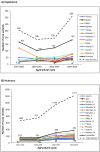Ecological and socio-cultural factors influencing in situ conservation of crop diversity by traditional Andean households in Peru
- PMID: 22146009
- PMCID: PMC3251544
- DOI: 10.1186/1746-4269-7-40
Ecological and socio-cultural factors influencing in situ conservation of crop diversity by traditional Andean households in Peru
Abstract
Background: The Peruvian Andean region is a main center of plant domestication of the world. There, several tuber species were domesticated and the area lodges one of the most important reservoirs of their varieties and wild relatives. It is also the setting of traditional cultures using and conserving them. However, crop genetic erosion has been reported in the region since several decades ago; therefore, understanding factors influencing both loss and maintenance of crop variation is relevant to design conservation policies. Previous researches have examined factors influencing agrobiodiversity conservation in the region but additional case studies are recognized to be still necessary for a deeper understanding of causes of genetic erosion and for policy design to prevent and remedy it. Our study focused on analyzing (1) variation in richness of traditional varieties of tubers cultivated among households, (2) changes in varieties richness occurred in four consecutive agricultural cycles, and (3) ecological, social, and cultural factors influencing loss and conservation of varieties.
Methods: Richness of farmer varieties of tuber species cultivated by 28 peasant households was monitored in communities of Cajamarca and Huánuco, Peru during four consecutive agricultural cycles (from 2001 to 2005). In-depth interviews were conducted with 12 of the households with higher reputation as conservationists, in order to document farmers' perception of tubers qualities in ecological, social, economic, technological and culinary aspects and how these influence their decisions of conservation priorities. Traditional varieties were identified according to their local names, which were then confronted among farmers and with scientific catalogues in order to identify synonyms. Based on the information documented, indexes of ecological and socio-cultural factors affecting agricultural practices were designed, and their linear correlations and multivariate relations with varieties richness managed per household were analyzed in order to explore factors with higher influence on conservation of crop variation.
Results: A total of 1483 and 507 farmer varieties of tuber species were found in the whole sample and period studied in Huánuco and Cajamarca, respectively. Significantly more varieties managed per household per year were recorded in Huánuco (146.39 ± 12.02) than in Cajamarca (44.55 ± 9.26), and marked differences in number of varieties per year were documented among households within each region (78.25 to 246.50 in Huánuco, 7.50 to 144.00 in Cajamarca). Correlation and multivariate analyses identified that the extent of agricultural area managed by households, cultural identity, practicing of traditional agricultural techniques, and level of self-sufficiency, are meaningful factors influencing higher varieties richness maintained by households. Yield and culinary attributes were considered by people as main features for selecting and deciding which varieties are priorities for conservation.
Conclusions: Maintenance and promotion of indigenous Andean culture is crucial for ensuring conservation of both traditional agroecological systems and agrobiodiversity. Policies supporting Andean culture (through educational, cultural and economic programs) are therefore directly connected with conservation of traditional farmer varieties. Promotion of seed availability and interchange are effective actions for maintaining and developing diversity, but using and valuing native tubers at regional, national and international levels are fundamental motivations to enhance policies and processes in this direction.
Figures






Similar articles
-
Cultural, economic, and ecological factors influencing management of wild plants and mushrooms interchanged in Purépecha markets of Mexico.J Ethnobiol Ethnomed. 2018 Nov 20;14(1):68. doi: 10.1186/s13002-018-0269-9. J Ethnobiol Ethnomed. 2018. PMID: 30454000 Free PMC article.
-
Agrobiodiversity and in situ conservation in ethnic minority communities of Xishuangbanna in Yunnan Province, Southwest China.J Ethnobiol Ethnomed. 2017 May 15;13(1):28. doi: 10.1186/s13002-017-0158-7. J Ethnobiol Ethnomed. 2017. PMID: 28506271 Free PMC article.
-
Status and factors influencing on-farm conservation of Kam Sweet Rice (Oryza sativa L.) genetic resources in southeast Guizhou Province, China.J Ethnobiol Ethnomed. 2018 Nov 29;14(1):76. doi: 10.1186/s13002-018-0256-1. J Ethnobiol Ethnomed. 2018. PMID: 30497534 Free PMC article.
-
Brazilian and Mexican experiences in the study of incipient domestication.J Ethnobiol Ethnomed. 2014 Apr 2;10:33. doi: 10.1186/1746-4269-10-33. J Ethnobiol Ethnomed. 2014. PMID: 24694009 Free PMC article. Review.
-
Crop genetic erosion: understanding and responding to loss of crop diversity.New Phytol. 2022 Jan;233(1):84-118. doi: 10.1111/nph.17733. Epub 2021 Oct 20. New Phytol. 2022. PMID: 34515358 Review.
Cited by
-
Domesticated, Genetically Engineered, and Wild Plant Relatives Exhibit Unintended Phenotypic Differences: A Comparative Meta-Analysis Profiling Rice, Canola, Maize, Sunflower, and Pumpkin.Front Plant Sci. 2017 Dec 5;8:2030. doi: 10.3389/fpls.2017.02030. eCollection 2017. Front Plant Sci. 2017. PMID: 29259610 Free PMC article.
-
TOCOSH FLOUR (Solanum tuberosum L.): A Toxicological Assessment of Traditional Peruvian Fermented Potatoes.Foods. 2020 Jun 2;9(6):719. doi: 10.3390/foods9060719. Foods. 2020. PMID: 32498434 Free PMC article.
-
Management, morphological and genetic diversity of domesticated agaves in Michoacán, México.J Ethnobiol Ethnomed. 2020 Jan 16;16(1):3. doi: 10.1186/s13002-020-0353-9. J Ethnobiol Ethnomed. 2020. PMID: 31948439 Free PMC article.
-
Folk taxonomy and traditional uses of common bean (Phaseolus vulgaris L.) landraces by the sociolinguistic groups in the central region of the Republic of Benin.J Ethnobiol Ethnomed. 2018 Jul 31;14(1):52. doi: 10.1186/s13002-018-0251-6. J Ethnobiol Ethnomed. 2018. PMID: 30064456 Free PMC article.
-
Gathering, agriculture, and exchange: an ethnoecological approach to the study of food patterns and feedstuff sources in communities of the Central Andes, Peru.J Ethnobiol Ethnomed. 2024 Jul 24;20(1):69. doi: 10.1186/s13002-024-00705-9. J Ethnobiol Ethnomed. 2024. PMID: 39049116 Free PMC article.
References
-
- Vavilov N. The origin, variation, immunity and breeding of cultivated plants. Chron Bot. 1951;13:1–366.
-
- Brack A. Perú-Diez Mil Años de Domesticación. Lima: PNUD; 2003. - PubMed
-
- Harlan J. Crops and Man. Foundation for Modern Crop Science Series. Madison, Wisconsin: American Society of Agronomy and Crop Science Society of America; 1975.
-
- Brush SB, Carney BH, Huamán Z. Dynamics of Andean potato agriculture. Econ Bot. 1981;35:70–85. doi: 10.1007/BF02859217. - DOI
-
- Brush SB. Farmers' Bounty: Locating crop diversity in the contemporary World. New Haven: Yale University Press; 2004. - PubMed
Publication types
MeSH terms
LinkOut - more resources
Full Text Sources

